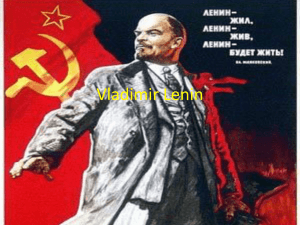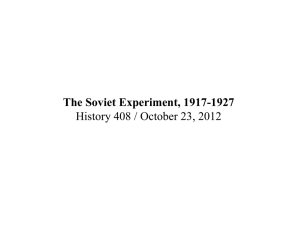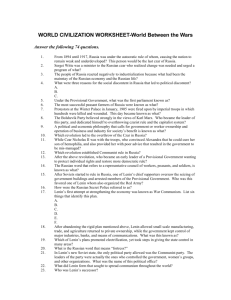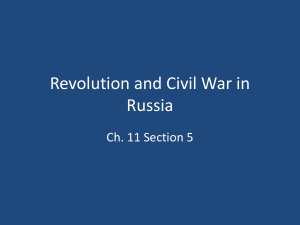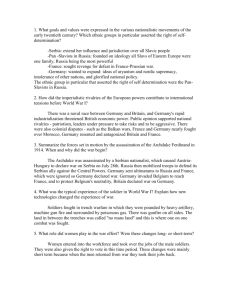NEP 2 - long essay.doc
advertisement
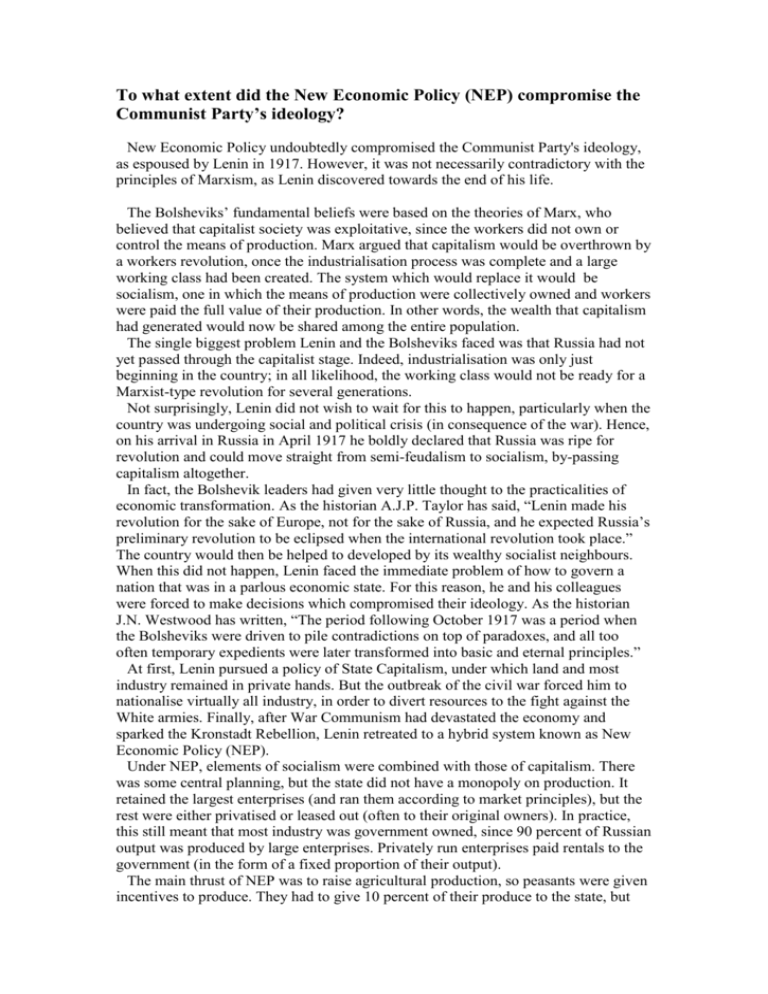
To what extent did the New Economic Policy (NEP) compromise the Communist Party’s ideology? New Economic Policy undoubtedly compromised the Communist Party's ideology, as espoused by Lenin in 1917. However, it was not necessarily contradictory with the principles of Marxism, as Lenin discovered towards the end of his life. The Bolsheviks’ fundamental beliefs were based on the theories of Marx, who believed that capitalist society was exploitative, since the workers did not own or control the means of production. Marx argued that capitalism would be overthrown by a workers revolution, once the industrialisation process was complete and a large working class had been created. The system which would replace it would be socialism, one in which the means of production were collectively owned and workers were paid the full value of their production. In other words, the wealth that capitalism had generated would now be shared among the entire population. The single biggest problem Lenin and the Bolsheviks faced was that Russia had not yet passed through the capitalist stage. Indeed, industrialisation was only just beginning in the country; in all likelihood, the working class would not be ready for a Marxist-type revolution for several generations. Not surprisingly, Lenin did not wish to wait for this to happen, particularly when the country was undergoing social and political crisis (in consequence of the war). Hence, on his arrival in Russia in April 1917 he boldly declared that Russia was ripe for revolution and could move straight from semi-feudalism to socialism, by-passing capitalism altogether. In fact, the Bolshevik leaders had given very little thought to the practicalities of economic transformation. As the historian A.J.P. Taylor has said, “Lenin made his revolution for the sake of Europe, not for the sake of Russia, and he expected Russia’s preliminary revolution to be eclipsed when the international revolution took place.” The country would then be helped to developed by its wealthy socialist neighbours. When this did not happen, Lenin faced the immediate problem of how to govern a nation that was in a parlous economic state. For this reason, he and his colleagues were forced to make decisions which compromised their ideology. As the historian J.N. Westwood has written, “The period following October 1917 was a period when the Bolsheviks were driven to pile contradictions on top of paradoxes, and all too often temporary expedients were later transformed into basic and eternal principles.” At first, Lenin pursued a policy of State Capitalism, under which land and most industry remained in private hands. But the outbreak of the civil war forced him to nationalise virtually all industry, in order to divert resources to the fight against the White armies. Finally, after War Communism had devastated the economy and sparked the Kronstadt Rebellion, Lenin retreated to a hybrid system known as New Economic Policy (NEP). Under NEP, elements of socialism were combined with those of capitalism. There was some central planning, but the state did not have a monopoly on production. It retained the largest enterprises (and ran them according to market principles), but the rest were either privatised or leased out (often to their original owners). In practice, this still meant that most industry was government owned, since 90 percent of Russian output was produced by large enterprises. Privately run enterprises paid rentals to the government (in the form of a fixed proportion of their output). The main thrust of NEP was to raise agricultural production, so peasants were given incentives to produce. They had to give 10 percent of their produce to the state, but could sell the rest on the market. Rich peasants (kulaks) were even allowed to hire labourers. In the words of historian Orlando Figes, “Having defeated the Whites … the Bolsheviks surrendered to the peasantry.” In industry, the situation was somewhat different. There was some central planning, but production was carried out in state, private and cooperative enterprises. The state retained the largest enterprises (and ran them according to market principles), but either privatised or leased out the rest (often to their original owners). In practice, this still meant that most industry was government owned, since 90 percent of Russian output was produced by large enterprises. Privately run enterprises paid rentals to the government (in the form of a fixed proportion of their output). Lenin's new slogan for Communist Party members was ‘Learn to trade’. There can be no doubt that NEP represented a retreat from Bolshevik ideology, particularly with regard to agriculture. However, it could be also argued that such a retreat was quite compatible with Marxism. Marx recognised that capitalism was a necessary phase of development, since it would generate rapid industrial growth (the reason being that growth required exploitation, since profits were necessary to finance investment). In his April Theses, Lenin admitted that Russia had not yet passed through the capitalist stage. In other words, it had not developed sufficient industry or a large enough working class to enable it to move to socialism. Even so, Lenin knew that revolutions were difficult to achieve and usually occurred in times of crisis. Russia was undergoing just such a crisis in 1917, and if the Bolsheviks did not take their chance they might not get it again for a generation. As such, he abandoned Marx’s key precept that capitalism was a necessary stage of development, and declared that Russia could move straight to socialism. Indeed, his final words to the Congress of Soviets after seizing power were “We shall now proceed to construct the socialist order.” That task, of course, proved harder than was first assumed, and the experiences of War Communism convinced Lenin that economic growth could not be fostered by the elimination of capitalism. NEP was seen as a temporary retreat from socialism – a compromise necessary to repair the damage done to the economy by World War One, the two revolutions and the civil war. However, by the end of his life Lenin had begun to see NEP as a valid route to socialism – an evolutionary path rather than a revolutionary one, made necessary because Russia had not yet completed its capitalist stage. He recommended that the peasants be encouraged to adopt more socialistic practices by forming cooperatives. However, he cautioned his colleagues against using force to facilitate this transformation. If it took a generation to achieve true socialism, then so be it. The problem was that many Bolshevik leaders did not share Lenin’s benign view of NEP. As the historian Robert Service has said, many regarded it as “an excrescent boil on the body politic, and at worst a malignant cancer”. Not surprisingly, it became the principle topic of controversy in the years following Lenin’s death, and ultimately a springboard for the rise of Stalin. Hence, it can be seen that NEP did indeed contradict the socialist principles espoused by Lenin and his colleagues in 1917. However, it was not necessarily the wrong path for a Marxist party to pursue in a pre-capitalist society struggling to recover from the depredations of war and bad economic policy.

